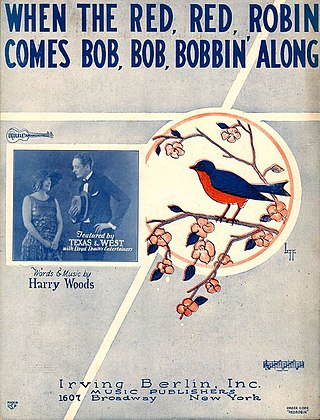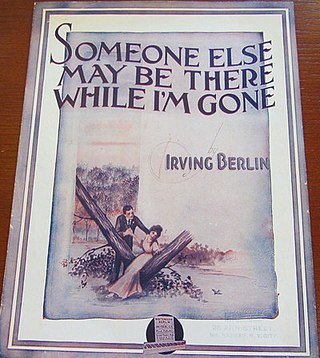"Can Anyone Explain? " is a popular song written by Bennie Benjamin and George David Weiss and published in 1950.
"The Breeze and I" is a popular song.
"If (They Made Me a King)" is a popular song with music written by Tolchard Evans and the lyrics written by Robert Hargreaves and Stanley J. Damerell. The song was written in 1934, but the most popular versions were recorded in 1950–1951. Perry Como's version, recorded November 28, 1950, was a number-one hit on the Billboard charts for eight weeks. The Como version was released under the following labels and catalog numbers:
"Dear Hearts and Gentle People" is a popular song published in 1949 with music by Sammy Fain and lyrics by Bob Hilliard. The song refers to the singer's hometown, and different versions allude to a range of U.S. states.
"Chattanoogie Shoe Shine Boy" is a popular song written by Harry Stone and Jack Stapp and published in 1950. It is the signature song of Red Foley who recorded it in late 1949. The song has been covered by many artists, including Bing Crosby, Frank Sinatra, and Faron Young who scored a hit with the song in 1959.
"The One I Love (Belongs to Somebody Else)" is a popular song composed by Isham Jones with lyrics by Gus Kahn. The song was recorded by Isham Jones' Orchestra on December 21, 1923, at Brunswick Studios in New York City, and published on January 7, 1924. On January 17 in Chicago, Jones recorded another version, with Al Jolson on lead vocals. Both versions made the charts that Spring, with Jolson's peaking at number 2, and Jones' at number 5. Sophie Tucker recorded her version February 1924, released on Okeh 40054.

"I'm Sitting on Top of the World" is a popular song with music written by Ray Henderson and lyrics by Sam M. Lewis and Joe Young. It was published in 1925.

"Rock-a-Bye Your Baby with a Dixie Melody" is a popular song written by Jean Schwartz, with lyrics by Sam M. Lewis and Joe Young. The song was introduced by Al Jolson in the Broadway musical Sinbad and published in 1918.

"I Wonder Who's Kissing Her Now" is a popular song. The music was written by Harold Orlob, the lyrics by Will M. Hough and Frank R. Adams. Orlob worked for Joseph E. Howard generating songs for Howard's productions and Howard presented the song as his own work for several years. The song was published in 1909 and was first introduced in the 1909 musical The Prince of To-Night when it was performed by Henry Woodruff.

"Down Among the Sheltering Palms" is a popular song.
"Do I Love You?" is a 1939 popular song written by Cole Porter, for his musical Du Barry Was a Lady, where it was introduced by Ronald Graham and Ethel Merman.
"I Apologize" is a popular song written by Al Hoffman, Al Goodhart, and Ed Nelson.
"Snuggled on Your Shoulder (Cuddled in Your Arms)" is a popular song with music by Carmen Lombardo and lyrics by Joe Young, published in 1932.

"Way Down Yonder in New Orleans" is a popular song with music by John Turner Layton Jr. and lyrics by Henry Creamer. First published in 1922, it was advertised by Creamer and Layton as "A Southern Song, without A Mammy, A Mule, Or A Moon", a dig at some of the Tin Pan Alley clichés of the era.
"Flamingo" (1940) is a popular song and jazz standard written by Ted Grouya with lyrics by Edmund Anderson and first recorded by singer Herb Jeffries and the Duke Ellington Orchestra on December 28, 1940, for Victor Records. This briefly reached the Billboard charts in 1941.

"Runnin' Wild" is a popular song first composed and recorded in 1922, written by Arthur Harrington Gibbs with lyrics by Joe Grey and Leo Wood.

"When the Red, Red Robin " is a popular song written, both words and music, by Harry Woods in 1926. The song became the signature song for singer and actress Lillian Roth, who performed it often during the height of her musical career from the late 1920s to the late 1930s.
"Our Love Affair" is a song recorded by Frank Sinatra with the Tommy Dorsey Band in 1940. which reached No. 5 in the Billboard charts. Its music is by Roger Edens and lyrics are by Arthur Freed. It was written for the M-G-M musical Strike Up the Band (1940), starring Mickey Rooney and Judy Garland.

"Someone Else May Be There While I'm Gone" is a World War I era song written by Irving Berlin and published as sheet music in 1917. The song, recorded by Al Jolson for Columbia Records on September 19, 1916 was very popular that year. Jolson recorded it again for Decca Records on December 5, 1947.
"Ruby" is the 1952 theme song for the film Ruby Gentry starring Jennifer Jones, written by Mitchell Parish and Heinz Roemheld. There were six charted versions of the song in 1953.








